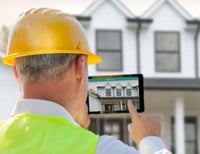For decades, home builders have struggled when it comes to communication with their home buyers. If you’ve ever built a home, then this concept is not lost on you. Homebuyers want frequent communication with their builders, and want to be in the know about the progress of their home. Historically, the builder’s number one priority has been to get the house built, not to be bothered with the homebuyer’s customer’s experience. But as we’ve entered the age of the customer, home builders can no longer stand out from the competition without providing a memorable customer experience. For this reason, builders are getting much more strategic on how to improve the experience of buying a home. User and usability testing are two techniques we implement to help builders achieve an improved customer experience.
User testing for home builders
 Ideas for new tools or apps commonly stem from a problem that a single person (more often than not, a CEO) has struggled with. Often this can lead to tunnel vision when it comes to the needs of the user. You, the owner of the product, are not necessarily the user. You may be, and likely are a user, but you simply cannot understand the needs of all potential users of your product. For instance, a home builder that builds 10 homes a year has very different needs than a home builder that’s building 100+. True user-centered design requires organizations to identify all the potential users of their product before beginning the design cycle or even thinking about beginning the development cycle of the product’s life. We do this through user-testing, which allows researchers to pinpoint different users and different problems that need solving. More importantly, user testing determines if this ‘problem’ even needs solving in the first place. User testing can be defined as determining the need for a product.
Ideas for new tools or apps commonly stem from a problem that a single person (more often than not, a CEO) has struggled with. Often this can lead to tunnel vision when it comes to the needs of the user. You, the owner of the product, are not necessarily the user. You may be, and likely are a user, but you simply cannot understand the needs of all potential users of your product. For instance, a home builder that builds 10 homes a year has very different needs than a home builder that’s building 100+. True user-centered design requires organizations to identify all the potential users of their product before beginning the design cycle or even thinking about beginning the development cycle of the product’s life. We do this through user-testing, which allows researchers to pinpoint different users and different problems that need solving. More importantly, user testing determines if this ‘problem’ even needs solving in the first place. User testing can be defined as determining the need for a product.
Usability testing for builders
Once the need for a product has been both identified and validated, you’re ready to move forward in the design process. Throughout the design and development of every Bokka project, we rely heavily on usability testing to evaluate efficiency, functionality, and overall ease of use of new products. You wouldn’t build a new home community without first doing feasibility studies on the location and product. Similarly, you should never build a new website (which will be your 24/7 online sales center) without proper usability testing.
The process of usability testing stems from user-centered design – where the user’s needs are put at the center of every decision made in regard to design and development.
To illustrate this point, we at the Bokka Group have been researching and gathering data on the homebuilder – homebuyer relationship for nearly 20 years. The most common challenge we found, was that what causes customer satisfaction (and trust) to plummet is communication during construction. As a result, we developed a new product for the industry that solves the communication challenge. This app, Builder Signal, allows home builders to easily send photos and updates of construction progress that post in real-time to a homebuyer portal. This portal displays all updates, progress, and timeline of the project – from beginning to end. Having the ability to sit down with both builders and buyers to walk through the app in progress was critical to improving the product during early stages (well before released to the public).
Unlike user testing, which takes place during the ideation and research phase, usability testing occurs iteratively throughout the life-cycle of a product, weaving in and out through every stage of wireframes, mockups, dev, and so forth. If user testing is all about determining need, usability testing can be defined as focusing on function. In understanding the difference between user testing and usability testing, it comes down to a question: Do users need my app? vs. Can users use my app?
Fail early and often
If you’re developing a new product, your early prototypes during usability testing will hopefully expose failures. While this may seem counterintuitive, if your users (Nielsen Norman Group recommends a test group of 5) interact with your product and have a negative experience, you gain clear direction of what needs to be redesigned, removed, added, etc. This helps with improving the overall functionality and life of the product in future iterations. Testing the usability of your product early in the process allows you to fail early and often, leading to a much better, finished product, app, or website. And early usability testing means you improve your product at a fraction of the cost.
A few tips when it comes to usability testing:
1) Conduct usability testing in person. You’re never going to get all the insight you need by giving someone a survey with questions to answer about their experience.
2) Ask ‘Tell Me More.’ Tell me more about why you looked there. Tell me more about why you wanted to do (X) — this will get your users talking and will be leaps more valuable than simple yes or no questions
3) Make sure your users know they aren’t being tested, your product and designs are being tested. Too often users fear they are being tested. As a result, are shy about sharing with you the things that don’t work. This results in a waste of both their and your time.
4) Have clear tasks and scenarios you want your users to achieve. For example, while testing Builder Signal, a construction communication tool whose main function is to have builders post an update, we would ask users to ‘show us how you post an update’. Does their user path match the one first created? If not, dig deeper, and see what may have been missed.
So how do we use what we learn from testing to better reach the customer?
The more time we can spend with our users (both home builders and home buyers) — whether it’s during user research, user testing or usability testing — the more we’re able to learn about those users. This gives us a real strategic advantage in the market. By realizing a user’s frustrations/pain-points, goals, and desires, we’re able to improve the product in each iteration to meet those needs, rather than building a product based on what we just think our users need. Because we all know happens when we assume.
Learn more
To learn more about Bokka’s new app, visit www.buildersignal.com
If you’re interested in user testing for a product you’re developing, here are some great resources to get started:
https://downloads.usertesting.com/case-studies/usertesting_case-study_zillow.pdf
https://usabilityhub.com/examples
https://www.usertesting.com/blog/what-is-ux-research/
To learn more about how we can help you gain a competitive edge by creating a better customer experience, contact us.


